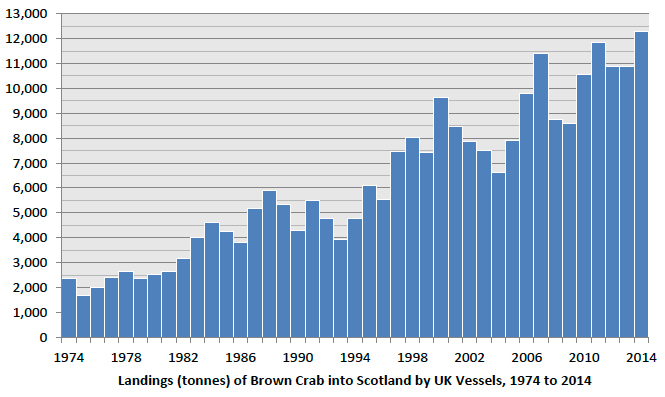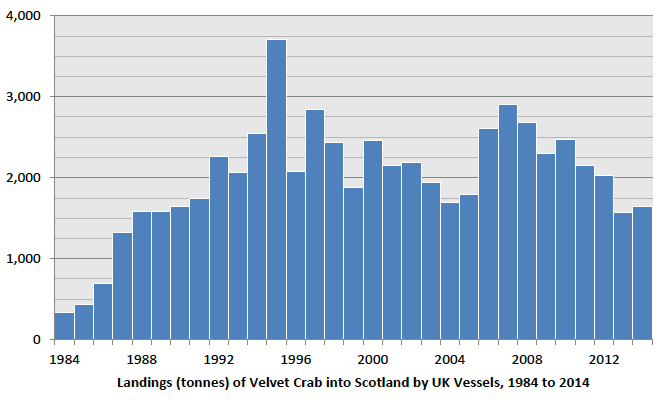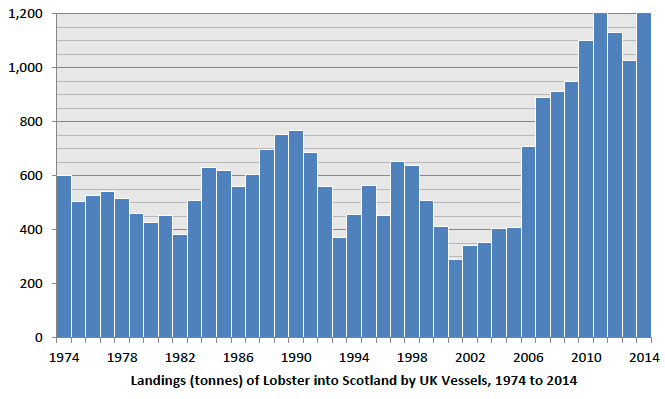Consultation on landing controls for the Scottish crab and lobster fisheries
A consultation on new management measures for Scotland's brown crab, velvet crab and lobster fisheries.
Consultation Document
Background
The crab and lobster fisheries are very important to many of Scotland’s fishing communities, and the importance of this sector has increased in the preceding decades as opportunities in other sectors of the industry have declined. In 2014, landings of brown crab, velvet crab and lobster were worth £32 million, helping to sustain hundreds of fishing vessels around the Scottish coast.
These three fisheries tend to be categorised together and share the following key features:
- They are fished using static gear (creels)
- Commercial fishing is restricted to those vessels which have a shellfish entitlement
- They are not covered by EU Total Allowable Catch ( TAC) provisions
- Landings are primarily managed through minimum landing size restrictions
Growing customer awareness regarding the provenance of seafood is leading to an increasing retail demand for shellfish that comes from sustainably exploited stocks, and there is growing concern from within the fishing industry regarding the current level of exploitation of Scotland’s crab and lobster fisheries. Fishing representatives, through IFMAC [1] , Inshore Fisheries Groups ( IFGs), and via individual fishing associations, have expressed a strong desire to Marine Scotland for new management measures to be introduced.
Marine Scotland’s Inshore Fisheries Strategy [2] sets out its vision for the management of the Scottish Inshore sector. It outlines the importance of fishing to Scotland’s coastal communities, economy, culture and heritage. A key aim of the strategy is to ensure that Scotland’s inshore fisheries are sustainably and effectively managed, in line with national objectives and international obligations such as the Marine Strategy Framework Directive.
The local fisheries management bodies for several of Scotland’s island communities (Orkney, the Outer Hebrides and Shetland) have already moved to implement new landing controls to better manage their shellfish stocks. The management measures proposed in this document are in line with those introduced in the islands.
Overview of stock assessments
Length Cohort Analysis ( LCA) is the method used for assessing Scotland’s crab and lobster stocks. It uses landings length frequency data collected as part of Marine Scotland Science’s market sampling programme.
The changes that LCA predicts are long term (equilibrium). The method does not provide any indication of short-term stock dynamics or recruitment over-fishing. Assessments are conducted on a regional basis and males and females are assessed separately. LCA results are presented in terms of yield-per-recruit and biomass-per-recruit, providing estimates of fishing mortality (F) and a framework for evaluation of management measures.
Assuming a direct relationship between fishing mortality and effort, lower levels of fishing effort will generally result in an increase in stock size and a reduction in landings. A higher level of fishing effort will reduce total stock biomass but landings may also fall, as animals are caught before they have had time to grow to a size that would contribute much weight to the yield (growth overfishing).
In between these lies F MAX, the fishing mortality rate that maximizes yield per recruit. As it is not possible to directly estimate the maximum sustainable yield ( MSY) for these stocks, F MAX is used as a proxy for F MSY.
The most recent stock assessments carried out for brown crab, velvet crab and lobster have shown that, in the majority of areas assessed, either one or both sexes for these stocks is currently being fished above the F MSY proxy.
The current management advice from Marine Scotland Science is that a higher yield and biomass could potentially be obtained in the long term by reducing the level of fishing mortality (effort) on stocks that are fished above the F MSY proxy.
Benefits of landing size provisions
The aim of minimum landing size ( MLS) provisions, which vary from species to species, is to prevent the landing of juvenile individuals. This allows them the opportunity to grow and reproduce before harvesting. A higher MLS increases the chances of individuals being able to reproduce before being harvested, potentially increasing a fishery’s yield and spawning stock biomass.
There are currently a variety of MLS’ in place for brown crab, velvet crab and lobster throughout Scotland, as outlined below.
| Species |
MLS (mm) |
Area |
Year introduced |
|---|---|---|---|
| Brown Crab |
130 |
East coast south of 56° (exc. Firth of Forth) |
2000 |
| 140 |
All areas (exc. east coast south of 56° & Outer Hebrides) |
2000 |
|
| 150 |
Outer Hebrides |
2015 |
|
| Velvet Crab |
65 |
All areas (exc. below) |
1989 |
| 70 |
Shetland |
2001 |
|
| 70 |
Outer Hebrides |
2015 |
|
| 70 |
Orkney |
2016 |
|
| Lobster |
87 |
All areas (exc. below) |
1999 |
| 90 |
Shetland |
2001 |
|
| 88* |
Outer Hebrides |
2015 |
|
| 88 † |
Orkney |
2016 |
CW – Carapace width
CL – Carapace length
*Moving to 90 mm from May 2016
†Moving to 90 mm from Mar 2017
Scope of this consultation
Marine Scotland is consulting on a range of landing restrictions for the brown crab, velvet crab and lobsters fisheries, in response to the calls from the fishing industry via IFMAC, IFGs and fishing associations. As individual management measures for crab and lobster have already been implemented in the island communities of Orkney, the Outer Hebrides and Shetland, the proposals in this consultation are primarily focused on the rest of Scotland's waters.
Calls for new landing controls have been made from right around the Scottish coast. However, Marine Scotland is aware that some fishermen may feel that the proposed measures may not be appropriate for their respective areas. We have therefore provided opportunities in this consultation for respondents to suggest areas where any new arrangements should not be introduced.
The following pages provide a general background on each species’ commercial fishery, the nature and status of their stocks, and the respective management measures being proposed.
Brown crab fishery
Commercial development
Brown crab ( Cancer pagurus), also known as edible crab, has long been fished off the Scottish coast. The commercial fishery has grown significantly over the past 40 years, with landings increasing progressively from ~2,000 tonnes per year in the mid-1970s to ~10-12,000 tonnes in recent years.
The value of the fishery has grown in line with the volume caught and landings in 2014 were worth £16.2 million, making brown crab the third most important commercial shellfish stock in Scotland after Nephrops and scallops.
Nature of the stock
The population structure of the species is poorly understood but it is found all around the Scottish coast in both inshore and offshore areas. The main fishing grounds were traditionally in the Hebrides, Orkney, East Coast and South Minch. However, the development of the fishery in the offshore grounds of Papa and Sule has contributed to the large increase in landings during the past couple of decades.
Brown crab grow by casting (moulting) their shell and then hardening a new larger shell. The growth rate of brown crab varies around the coast but female brown crab in Scottish waters typically mature between 130-150 mm.
State of the stock
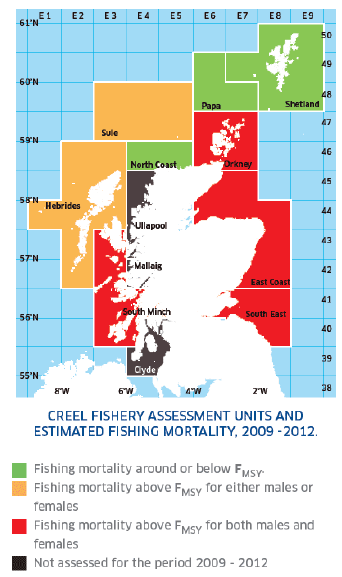
The most recent assessments carried out by Marine Scotland Science, summarised on the adjacent diagram, show that the brown crab stocks in the catching areas of the Hebrides, Sule, South Minch and Orkney – as well as the east coast – are currently fished at or above the F MSY proxy.
Management proposals
Two minimum landing sizes for brown crab have been in effect around the majority of the Scottish coast since 2000:
- 130 mm carapace width for the east coast south of 56°, excluding the Firth of Forth
- 140 mm carapace width for all other areas. except for the east coast South of 56° and the Outer Hebrides
In the Outer Hebrides the MLS was increased from 140 mm to 150 mm in 2015, following proposals put forward by the area’s Inshore Fisheries Group.
It is now proposed to increase the MLS for brown crab to 150 mm for the rest of the Scottish coast.
Q1. Do you support increasing the minimum landing size for brown crab to 150 mm carapace width?
a) Yes
b) No
Q2. Are there any areas of the coast that you think should be excluded from an MLS increase for brown crab, and if so why?
Velvet crab fishery
Commercial development
Velvet crab ( Necora puber) was once considered a ‘pest species’ in Scotland, with a commercial fishery only developing following the collapse of the Spanish stock in the 1980s. The Scottish fishery expanded significantly as a result, with landings increasing five-fold from 300 tonnes in 1984 to 1,600 tonnes in 2014. Scotland’s velvet crab fishery is now the largest in Europe, with the 2014 catch valued at over £4 million.
Nature of the stock
Velvet crab can be found in waters all around the British Isles. Traditionally the majority of landings have come from the west coast of Scotland, Shetland and Orkney; however landings from the east coast have increased significantly during the past 15 years.
Female velvet crabs are known to grow more slowly and to a smaller maximum size than males, which is likely due to reduced growth during the females' egg bearing phase.
State of the stock
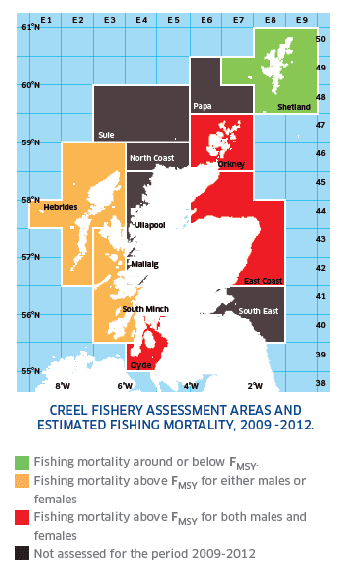
The most recent assessment carried out by Marine Scotland Science, summarised in the adjacent diagram, shows that the velvet crab stocks in the catching areas in the west coast, east coast and Orkney are currently fished at or above the F MSY proxy.
Management proposals
Minimum landing size increase
A minimum landing size for velvet crab of 65 mm carapace width has been in effect around the majority of the Scottish coast since 1989.
In Shetland, the MLS was increased to 70 mm by the Shetland Shellfish Management Organisation in 2001.
Following separate consultations, increases to 70 mm were introduced in the Outer Hebrides and Orkney from 2015 and 2016 respectively.
It is now proposed to increase the MLS for velvet crab to 70 mm for the rest of the Scottish coast.
Q3. Do you support increasing the minimum landing size for velvet crab to 70 mm carapace width?
a) Yes
b) No
Q4. Are there any areas of the coast that you think should be excluded from an MLS increase for velvet crab, and if so why?
Berried velvet crab
In Orkney, a ban on the landing of berried (i.e. egg bearing) velvet crab is being introduced from 2016, in order to provide additional protection to reproductive females and potentially improve recruitment to the fishery by increasing egg production [5] .
It is now proposed to introduce a prohibition on the landing of berried velvet crab for the rest of the Scottish coast.
Q5. Do you support prohibiting the landing of berried velvet crab?
a) Yes
b) No
Q6. Are there any areas of the coast that you think should be excluded from a prohibition on landing berried velvet crabs, and if so why?
Lobster fishery
Commercial development
European lobster ( Homarus gammarus) has long been a key stock for communities around the Scottish coast and has been targeted for many centuries. As with the brown crab and velvet crab fisheries, the level of commercial exploitation has increased considerably over recent decades, with over 1,200 tonnes of lobster valued at £12 million landed into Scotland in 2014.
Nature of the stock
Lobster is found all around the Scottish coast, usually on hard ground in water shallower than 30 metres.
Substrate and suitable shelter are thought to affect the size and population density, with larger lobsters being found on more exposed grounds. Lobsters are not known to undertake extensive migrations and genetic variation of lobsters is thought to be low throughout the Scottish coast.
The growth rate of lobsters does vary around the Scottish coast and, as with other crustaceans, lobsters moult their shells in order to grow. The size at maturity is also variable; females in the south east, for example, mature at a smaller size than those found around the Outer Hebrides.
State of the stock
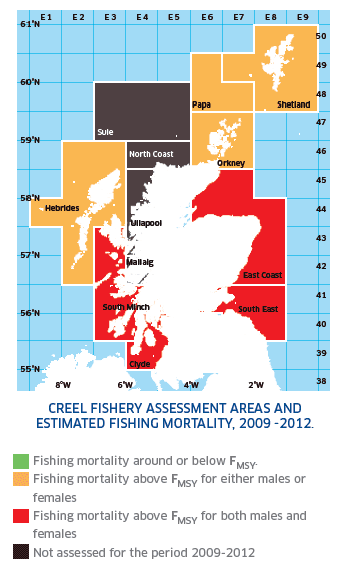
The most recent assessments carried out by Marine Scotland Science, summarised in the adjacent diagram, show that lobster is currently being fished at or above the F MSY proxy in all of the areas assessed. The scientific advice is that a higher yield and biomass could potentially be obtained from the stock in the long term if measures to reduce the level of fishing mortality (effort) were introduced.
Management proposals
Minimum Landing Size
A minimum landing size for lobster of 87 mm carapace length has been in effect around the majority of the Scottish coast since 1999.
In Shetland, the MLS was increased to 90 mm by the Shetland Shellfish Management Organisation in 2001.
Following separate consultations, increases to 90 mm were introduced in the Outer Hebrides and Orkney on a staggered basis from 2015 and 2016 respectively.
It is now proposed to increase the MLS for lobster to 90 mm for the rest of the Scottish coast.
Q7. Do you support increasing the minimum landing size for lobster to 90 mm carapace length?
a) Yes
b) No
Q8. Are there any areas of the coast that you think should be excluded from an increase in MLS for lobster, and if so why?
As stated above, the MLS increases for Orkney and the Outer Hebrides are being implemented on a staggered basis. This has involved an immediate increase to 88 mm upon introduction, followed by a further increase to 90 mm one year thereafter.
It is proposed that an MLS increase for the rest of the Scottish coast be implemented on a similar basis. However, alternative options are welcomed.
Q9. If you support an MLS increase, how would you prefer to see it introduced?
a) Immediate increase to 88 mm then to 90 mm one year thereafter
b) Other (please specify)
Maximum Landing Size
Due to evidence that larger female shellfish produce better quality eggs and in greater numbers, potentially resulting in greater recruitment to the fishery, a maximum landing size (M axLS) of 155 mm carapace length for female lobster has been in effect around the majority of the Scottish coast since 2004.
In the Outer Hebrides, the M axLS was reduced to 145 mm in 2015 in order to further protect its spawning stock.
It is now proposed to reduce the M axLS for female lobster to 145 mm carapace length for the rest of the Scottish coast.
Q10. Do you support decreasing the maximum landing size for female lobster to 145 mm carapace length?
a) Yes
b) No
Q11. Are there any areas of the coast that you think should be excluded from a maximum landing size reduction for female lobster, and if so why?
Due to evidence that female lobsters select the most dominant large males as mates [7] , it is proposed to extend the M axLS to include male lobster as well. This has the potential to promote reproduction in the fishery by protecting its most reproductive individuals.
Q12. Do you support introducing a maximum landing size for male lobster of 145 mm carapace length??
a) Yes
b) No
Q13. Are there any areas of the coast that you think should be excluded from a maximum landing size for male lobster, and if so why?
‘Crippled’ lobsters
Finally there is the issue of 'crippled' lobsters, which refers to animals that have lost one or both of their claws. These lobsters can be landed and sold but do not achieve the same price as those with both claws intact. However, if returned to the sea they are capable of re-growing their missing limb/s. There is anecdotal evidence that these animals are already returned to the sea by many fishermen.
In the Outer Hebrides, a ban on the landing of crippled lobsters was introduced in 2015. It is proposed to extend this prohibition to the rest of the Scottish coast.
Q14. Do you support prohibiting the landing of 'crippled' lobsters?
a) Yes
b) No
Q15. Are there any areas of the coast that you think should be excluded from a prohibition on the landing of ‘crippled’ lobsters, and if so why?
Sale and carriage restrictions
The outcome of this consultation may result in one or more of the proposed landing controls for brown crab, velvet crab and lobster being in effect on a uniform basis across the entire Scottish coast.
It is proposed that, in those circumstances, matching restrictions on sale and carriage are also introduced in order to aid the enforcement of any uniformly-implemented controls.
Q16. Do you support the introduction of prohibitions on sale and carriage to match any landing prohibitions that are implemented on a uniform basis across the entire Scottish coast?
a) Yes
b) No
Contact
There is a problem
Thanks for your feedback
